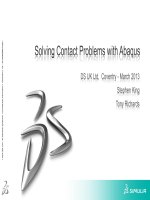Lecture Management information systems: Solving business problems with information technology – Chapter 10
Bạn đang xem bản rút gọn của tài liệu. Xem và tải ngay bản đầy đủ của tài liệu tại đây (770.32 KB, 37 trang )
Introduction to MIS
Chapter 10
Strategic Analysis
Copyright © 1998-2002 by Jerry Post
Introduction to MIS
1
Strategy
Connections to
suppliers and
customers.
Competition
Become the best firm in the
industry. Block the
competitors by keeping your
customers happy.
Introduction to MIS
2
Outline
The Competitive Environment
External Agents
IS Techniques to Gain Competitive Advantage
The Search for Innovation
Research
Engineering and Design
Manufacturing
Logistics and Supply
Marketing
Sales and Order Management
Service
Management
Costs and Dangers of Strategies
Operations, Tactics, Strategy
E-Commerce Failures
Cases: Travel Industry
Appendix: Solving Business Problems and Cases
Introduction to MIS
3
Competition
Competition is increasing in many industries, but it is
particularly intense in the restaurant and fast food industry.
Competition encourages firms to hold down costs, provide
more variety, and provide new and better service to
customers.
Introduction to MIS
4
Porter’s Five Forces Model
Threat of
New Entrants
Rivalry Among
Existing Competitors
Bargaining Power
of Suppliers
Bargaining Power
of Buyers
Threat of Substitute
Products or Services
Introduction to MIS
5
Harvard Strategy
Formulation
(Deciding what to do.)
Implementation
(Achieving results.)
1. Org. structure & relation.
1. Identification of
opportunity and risk.
Corporate Strategy
2. Material,
technical, financial, &
human resources.
Pattern of
purposes and
policies
defining the
company and
its business
3. Personal values
and aspirations.
Introduction to MIS
2. Org. processes & behavior.
Standards and measurement.
Motivation & incentive systems.
Control systems.
Recruit & develop managers.
3. Top leadership.
Strategic
Organizational
Personal
4. Noneconomic
responsibility to
society.
Division of work.
Coord. divided responsib.
Information systems.
6
parts
supplier
parts
supplier
warehouse
supplier
supplier
tool
manufacturer
Manufacturer
wholesaler
wholesaler
distributor
Production
Chain
warehouse
supplier
workers
retail store
parts
supplier
distributor
retail store
distributor
retail store
retail store
Consumers
Introduction to MIS
7
Methods to Gain
Competitive
Advantage
Barrier
To Entry
Supplier
Supplier
Ties To
Suppliers
Decreased
Costs
Firm
Control Of
Distribution
Improved
Quality
Consumer
Introduction to MIS
Innovation and
Differentiation
Consumer
Consumer
Consumer
Increased
Switching Costs
Consumer
Rival
Wholesale
Ties To
Customers
Supplier
Consumer
Consumer
8
Barriers to Entry
Economies of Scale (size)
Economies of Scope (breadth)
Product Differentiation
Capital requirements
Cost Disadvantages (independent of size)
Distribution Channel Access
Government Policy
Introduction to MIS
9
Competitive Advantage
Barriers to Entry
Consumers incur learning
and data transfer costs.
Baxter Healthcare
Introduction to MIS
Monitoring production lines
and analyzing data. Digital
Equipment Corp.
Value Chain
Add new features or create
new products with IT.
Federal Express & Merrill
Lynch
Quality Management
IS to cut costs. Wal-Mart
Product Differentiation
Prevent others from entering
the industry. Napster
Switching Costs
Lower Production Costs
Distribution Channels
Additional costs of creating
an information system.
People’s Express
Expanding forward or back
the value chain to find
greater profits. Boeing
Information Systems
10
Value Chain
Firm Infrastructure
Human Resources Management
M
ar
gi
Technology Development
n
Introduction to MIS
Operations
Outbound Marketing
Logistics & Sales
Service
M
ar
gi
Inbound
Logistics
n
Procurement
11
Process Innovation
Suppliers
Production
Logistics/
Supply
Research
Engineering
and Design
Management
Manufacturing
Marketing
Customer
Service
Sales and
Order
Management
Customers
Introduction to MIS
12
Developing Strategies
Corporate Strategy Development
monitor
rivals
• expectations • strengths
• goals
• weaknesses
• rivalry
• opportunities
• critical success factors
Market Measures
Market share
Concentration
Growth
Profitability
Performance Measures
ROA
ROI
EPS
Growth
Subjective
Business Strategies
and Priorities
Process Changes
Data Needs
IS Changes
Cost
leadership
Differentiation
Innovation
Linkages
Reengineering
Organization
Decentralization
System
Development
& Implementation
Business Operations & Rules
Existing Data and IS
Introduction to MIS
13
Search for Innovation
Research
Analysis & modeling, project
management, work group
support, databases, decision
support.
Manufacturing
Engineering & Design
CAD/CAM, testing, networks,
work group support.
Logistics & Supply
Introduction to MIS
Mass customization, links to
customers & suppliers,
quality monitoring, expert
systems for maintenance,
production databases,
business integration.
Just-in-time linkages,
forecasts, models, links for
design, transaction
processing.
14
Search for Innovation
Marketing
Frequent buyer database,
target market & media
analysis, survey design and
analysis, multimedia
promotion design, links to
customers and designers.
Service
Management
Sales & Orders
Portable computers for
sales, ES for order
customization, work group
tools for customer support.
Phone support, GIS locators,
scheduling, ES diagnostics,
databases.
EIS, e-mail, bulletin boards,
decision support systems,
personal productivity tools,
work group support
Links to service providers
Introduction to MIS
Accountants
Consultants
Lawyers, . . .
15
Research
Analysis and models
Statistical analysis of data
Project management and budgeting
Work-group collaboration and communication
Introduction to MIS
16
Engineering and Design
CAD/CAM
Integrated design database
Production databases and model testing
Expert Systems for manufacturability
Work group communication
Introduction to MIS
17
Manufacturing
Links to customers
Links to suppliers
Mass customization
Robotics
Diagnostic Expert Systems
Quality monitoring and control
Introduction to MIS
18
Logistics and Supply
Just-In-Time Inventory and EDI
Configuration and design
Searching for availability, pricing, . . . networks
Introduction to MIS
19
Marketing
Frequent buyer databases
Point-of-Sale and trends
Statistical analysis of data
Geographic Information Systems
Links to external marketing agencies
Multimedia development of promotions
Internet
Introduction to MIS
20
Sales and Orders
Sales force automation, hand-held computers
Customer Internet access
Expert Systems for product and option selection
Expert Systems for configuration and shipping
Front-line support: ES, e-mail, work groups
Introduction to MIS
21
Service
Portable computers for service anywhere
Databases (e.g., customer service)
Location monitoring of service personnel
Product internal, automatic diagnostics
Expert System diagnostic tools
Introduction to MIS
22
Management
Executive Information Systems
Simulation (and rivalry games)
Links to external partners (accounting, law, . . .)
Electronic conferencing
Work group communication, e-mail
Standardization, Modularization, Franchises
Knowledge Workers
Client-server instead of hierarchical computing
Introduction to MIS
23
Strategy Analysis
Product Differentiation
Skills & Resources
Strong marketing.
Product engineering.
Basic research.
Distribution channel
cooperation.
Skills & Resources
Internal coordination.
Incentives for innovation.
Resources to attract skills.
Risks
Cost Leadership
Organization Requirements
Competitors imitate.
Customers do not accept.
Cost is too high.
Introduction to MIS
Continued capital
investment.
Process engineering.
Continuous quality
improvement.
Tight supervision of costs.
Products designed for low
cost.
Low cost distribution.
Organization Requirements
Tight cost controls.
Frequent control reports.
Highly structured org.
Incentives based on
qualitative measures.
24
Strategy Analysis
Cost Leadership
Risks
Customer-Supplier Links
Competitors imitate.
Technology changes.
Lose production or
distribution advantage.
Skills & Resources
Organization Requirements
Introduction to MIS
Flexibility to respond to
customers.
Service culture.
Ability to adapt to
emergencies.
Risks
Influence with partners
Communication channels
Standards or agreements.
Security threats.
Changing standards.
Competitors copy with
more/better links.
25









